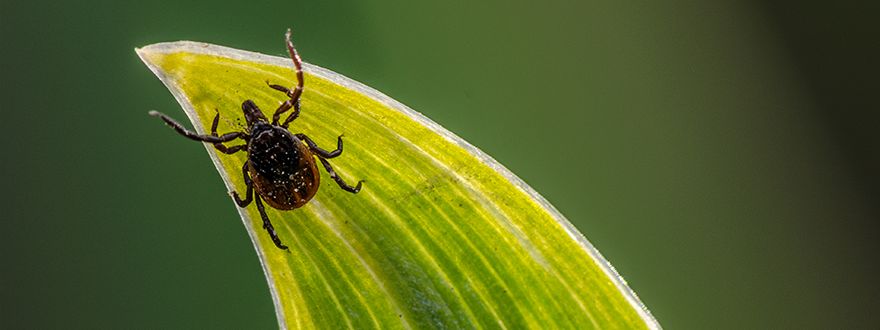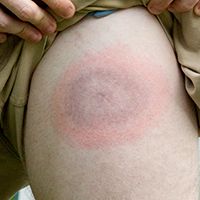
read time: 4 min
Health & Wellness
Tiny insects come with big health risks
If the mere thought of a tick crawling on you makes you squeamish, you’re not alone. For many of us, ticks trigger feelings of fear and anxiety—and for good reason. Known to carry illnesses that can be transmitted to humans, these tiny bloodsuckers can have a big impact on your health.
Despite the prevalence of ticks across the US, there is often confusion about how to deal with tick bites and the infections they can cause, as well as how to know if and when you should be tested. Let’s explore common concerns to uncover the facts you need to know in case you are bitten by a tick.
How ticks transmit disease
Ticks climb to the tips of leaves and tall grass and wait for an animal or human—known as a host—to brush by. After crawling on, they attach to the host’s skin, insert their feeding tube, and make a meal of their blood.1 (Sounds awful, right?)
Fortunately, not all ticks carry disease. A tick must have an infectious bacteria, virus, or parasite inside of them in order to spread it to a host. An infected tick can transfer the infection into the host’s bloodstream while feeding. In the case of Lyme disease, the blacklegged tick must be carrying a certain type of bacteria—usually the Borrelia burgdorferi type, but sometimes Borrelia mayonii2—and remain attached for 36 to 48 hours to infect the host.
The process of how Lyme disease and other illnesses are passed from a tick to a human is well understood. But knowing if you are infected isn’t as straightforward.
Be aware of signs and symptoms
Symptoms of Lyme disease can vary widely depending on how long you’ve been infected and how your body responds to the bacteria. Generally, people who get the disease exhibit early symptoms 3 to 30 days after being bitten by a tick. Experiencing these signs is a red flag that you need to be tested.
Rash: not always a bull's-eye
While the bull’s-eye shape is most common, the appearance and location of the rash can vary.4 In some cases, the rash may not appear at the site of the tick bite, it may look more like a blister than a bull's-eye, or it may not develop at all. If the rash is under your hairline or in another tricky-to-see location, you may not even notice it. Infectious disease experts still aren’t sure why this wide variation in symptoms occurs. But, now that you know you can’t count on seeing a bull's-eye rash, what other signs could tip you off that you have Lyme disease?

Early warning signs similar to flu

Broad spectrum of later-stage symptoms
Joint swelling, muscle pain, and nerve pain are common signs of Lyme disease, but people may also experience neurological symptoms, like migraines, neck stiffness, numbness or tingling in the hands or feet, facial palsy (drooping of the facial muscles), or irregular heartbeats.6 While rare, bacteria transmitted by ticks can also lead to meningitis and encephalitis, conditions that can cause spinal cord and brain inflammation.7

Ticks and meat allergies
One of the more puzzling side effects of tick-borne illness is the potential to develop an allergy to mammalian meat, more commonly known as red meat. The lone star tick can carry a certain sugar that is also found in beef, pork, lamb, and other red meat. If that sugar is transferred to your body, you may develop the allergy.8
While rare, this condition—known as alpha-gal syndrome (AGS)—can be quite serious. Like any food allergy, reactions can vary from mild to severe. In some cases, people experience a potentially life-threatening allergic reaction that requires urgent medical care. People with alpha-gal syndrome avoid eating red meat in order to manage the allergy.9
When to test for Lyme disease
You may have heard that Lyme disease tests can’t detect the infection right away, and that’s true. Testing for tick-borne diseases is all about timing.
Most tests for illnesses are antibody-based blood tests.10 By checking for antibodies—proteins made by your immune system to help fight infection—it’s possible to know if you’ve been infected. It takes about 10 to 14 days after being bitten by a tick for your body to produce an antibody response to the Lyme-causing Borrelia burgdorferi bacteria. So, an antibody blood test won’t show a positive result right away.
Lyme Disease Test With Confirmation
Uses the CDC recommended 2-step testing process for Lyme disease.
$89.00
It is possible to get a false negative result, even if you are infected. Depending on your symptoms and how long you’ve had them, you may need to be tested again to see if your body is producing antibodies. If you test positive for Lyme disease, your blood sample will be retested to confirm the diagnosis is correct.
Some of the less common tick-borne illnesses, like Heartland, Bourbon, and Powassan viruses, don’t have commercially available tests at all. If you live in or have traveled to an area where these diseases have been reported and you are experiencing symptoms, your doctor may reach out to your local health department or the Centers for Disease Control and Prevention (CDC) to arrange specialized testing.
Testing the tick for disease
One unique way to test for Lyme disease right away is to go straight to the source and test the tick itself. Commercial labs, like Quest, as well as several public health programs around the country, test ticks for disease. If the results come back positive for a disease-causing bacteria, your doctor may prescribe antibiotics as a precaution in case you are infected.
Early diagnosis is important for effectively treating tick-borne illnesses. That’s why the infectious disease and diagnostics community is involved in several projects aimed at developing new testing solutions for earlier detection.11
Treatments to cure Lyme disease
If you have Lyme disease, you won’t have it forever. Lyme disease and other bacteria-based tick-borne illnesses are typically curable through the use of antibiotics.12
For virus-based tick-borne illnesses, such as Bourbon virus, Colorado tick fever, Heartland virus, and Powassan virus, there is no treatment. You simply need to wait for the virus to run its course.
DIY prevention for tick bites and Lyme disease
There are several simple steps you can take to prevent tick-borne illness.
Consider geography and seasonality
Each tick species lives in a specific region, so it’s important to know which types are around you, whether you’re at home or traveling.16 Ticks are typically most active during the warmer spring and summer months, but adult ticks can be active in the fall as well.
Gear up to go out
When venturing outdoors in areas prone to ticks, wear long pants and sleeves and use an insect repellent recommended by the Environmental Protection Agency (EPA). You can also tuck your pants into your socks for extra protection.
If you spend time outdoors, it’s likely that you’ll cross paths with a tick at some point. While you may always feel uneasy (or maybe even queasy) about these tiny parasites, they shouldn’t stop you from enjoying nature. Knowing the truth about ticks and tick-borne illnesses is the best way to steer clear of these bloodsucking hitchhikers and protect yourself.
References
1 How ticks spread disease.
Centers for Disease Control and Prevention. Published September 21, 2020. Accessed May 23, 2023. https://www.cdc.gov/ticks/life_cycle_and_hosts.html
2 Lyme disease.
Centers for Disease Control and Prevention. Published January 19, 2022. Accessed May 23, 2023. https://www.cdc.gov/lyme/
3 Lyme disease rashes and look-alikes.
Centers for Disease Control and Prevention. Published March 10, 2023. Accessed May 23, 2023. https://www.cdc.gov/lyme/signs_symptoms/rashes.html
4 The many forms of Lyme disease rashes.
Centers for Disease Control and Prevention. No date. Accessed May 23, 2023. https://www.cdc.gov/lyme/resources/NCEZID_rash_poster3r1-508.pdf
5 Signs and symptoms of untreated Lyme disease.
Centers for Disease Control and Prevention. Published January 15, 2021. Accessed May 24, 2023. https://www.cdc.gov/lyme/signs_symptoms/index.html
6 Neurologic Lyme disease.
Centers for Disease Control and Prevention. Published August 11, 2021. Accessed May 24, 2023. https://www.cdc.gov/lyme/treatment/NeurologicLyme.html
7 Tick-borne encephalitis (TBE)—symptoms, diagnosis, and treatment.
Centers for Disease Control and Prevention. Published October 14, 2022. Accessed May 23, 2023. https://www.cdc.gov/tick-borne-encephalitis/symptoms-diagnosis-treatment/index.html
8 Alpha-gal syndrome.
Centers for Disease Control and Prevention. Published April 14, 2023. Accessed May 23, 2023. https://www.cdc.gov/ticks/alpha-gal/index.html
9 Meat allergy.
American College of Allergy, Asthma & Immunology. No date. Accessed May 23, 2023. https://acaai.org/allergies/allergic-conditions/food/meat/
10 Lyme disease diagnosis and testing.
Centers for Disease Control and Prevention. Published May 21, 2021. Accessed May 24, 2023. https://www.cdc.gov/lyme/diagnosistesting/index.html
11 Lyme disease diagnostics research.
National Institute of Allergy and Infectious Diseases. Published November 20, 2018. Accessed May 24, 2023. https://www.niaid.nih.gov/diseases-conditions/lyme-disease-diagnostics-research
12 Lyme disease antibiotic treatment research.
National Institute of Allergy and Infectious Diseases. Published November 20, 2018. Accessed May 24, 2023. https://www.niaid.nih.gov/diseases-conditions/lyme-disease-antibiotic-treatment-research
13 Post-treatment Lyme disease syndrome.
Centers for Disease Control and Prevention. Published January 10, 2022. Accessed May 24, 2023. https://www.cdc.gov/lyme/postlds/index.html
14 Lyme disease vaccine.
Centers for Disease Control and Prevention. Published August 11, 2022. Accessed May 24, 2023. https://www.cdc.gov/lyme/prev/vaccine.html
15 Tick-borne encephalitis (TBE)—Symptoms, Diagnosis, and Treatment.
Centers for Disease Control and Prevention. Published October 14, 2022. Accessed May 23, 2023. https://www.cdc.gov/tick-borne-encephalitis/symptoms-diagnosis-treatment/index.html
16 Regions where ticks live.
Centers for Disease Control and Prevention. Published December 5, 2022. Accessed May 24, 2023. https://www.cdc.gov/ticks/geographic_distribution.html










